Sustainable Irrigation Practices: Reducing the Need for Repair
Sustainable irrigation practices are becoming increasingly important for conserving water, reducing environmental impact, and extending the life of irrigation systems. By adopting eco-friendly techniques like xeriscaping, rainwater harvesting, and planting native species, you can significantly reduce the strain on your irrigation system.
These practices promote healthier landscapes and minimize the need for costly repairs, making them a smart choice for long-term landscape management.

Xeriscaping for Reduced Irrigation Repairs
Xeriscaping is a landscaping method that uses drought-tolerant plants and water-efficient design to create beautiful, low-maintenance landscapes. By choosing native plants that require minimal watering, xeriscaping significantly reduces the demand on irrigation systems, helping to prevent common issues like leaks, overwatering, and pipe damage. This approach not only conserves water but also minimizes the wear and tear on irrigation components, leading to fewer repair needs. One key benefit of xeriscaping is its ability to create natural landscapes that thrive with natural rainfall rather than relying solely on irrigation systems. By reducing the need for frequent watering, this method decreases the strain on irrigation equipment, lowering the likelihood of malfunctions. Thus, you can extend the lifespan of your system and avoid costly repairs. Xeriscaping also promotes healthier soil and plant life, reducing the risk of erosion and compaction that result from over-irrigation. This resilient landscaping technique conserves water and supports long-term ecosystem health, creating a self-sustaining environment that requires minimal intervention. As a result, property owners can enjoy lush, vibrant gardens with fewer interruptions for irrigation repairs and maintenance.Rainwater Harvesting for Reduced Irrigation Repairs
Rainwater harvesting is another effective method for reducing the reliance on traditional irrigation systems, in turn lowering repair frequency. By collecting and storing rainwater for landscape use, homeowners can minimize the demand on their irrigation systems, reducing wear and tear on pumps, valves, and pipes. This natural water source not only conserves water but extends the life of your system. Rainwater harvesting systems reduce the need for frequent irrigation, so overuse, leaks, and pressure imbalances won’t be a problem. Repairs then become less frequent and less costly because your irrigation system isn’t working so hard, making rainwater harvesting a smart choice for property owners. What’s great about this method is that it allows for consistent watering, even during droughts and water restrictions. Beyond reducing the need for repairs, rainwater harvesting also promotes sustainability by reducing the demand on municipal water supplies. Capturing and using rainwater helps to conserve resources and supports a more eco-friendly landscape management appraoch. As a result, property owners can enjoy a thriving, low-maintenance garden while cutting down on water usage and irrigation repairs and maintenance.
